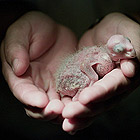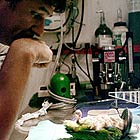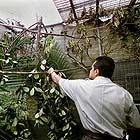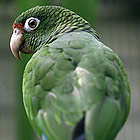|
 |
|
Esta página no está disponible en español. THE ORLANDO SENTINEL A Wing & A Prayer Avian experts are trying to reintroduce the nearly extinct Puerto Rican parrot to the wilds of the Caribbean. By Matthew Hay Brown | Sentinel Staff Writer July 3, 2004
Tender care. CARIBBEAN NATIONALFOREST, Puerto Rico -- Jafet Vélez Valentín cups his hands around the bright green bird. La Mohicana, as workers have named the 11-year-old female, has endured a lifetime of respiratory difficulty. This morning, her handlers found her sitting on the floor of her cage, refusing to eat. They rushed her into the clinic, laid her down on the table and put an oxygen mask over her head. Now she has stopped breathing altogether. Vélez, a wildlife biologist, calls for a syringe of the stimulant Dopram to revive her and directs an assistant to contact the veterinarian. He strokes the bird's chest with his thumb. He feels her lungs filling again. "Está volviendo," Vélez says. "She's coming back."
Hope at hand. Every bird is precious here at the Luquillo Aviary, where the U.S. Fish and Wildlife Service is working to save the most endangered parrot in the world. The Puerto Rican parrot once thrived in the lush green rain forest of this Caribbean island, where an estimated 1 million greeted Columbus 500 years ago. But a combination of deforestation by man, predation by natural enemies and devastation by periodic hurricanes has nearly wiped out the population. By 1975, the last native species of parrot found in U.S. territory was down to an estimated 13 birds.
Looking for help. Now the Puerto Rican Parrot Recovery Program is trying to bring it back. Working out of a converted Army facility high in the mountainous Caribbean National Forest -- the 43-square-mile reserve in northeastern Puerto Rico known popularly as El Yunque -- wildlife specialists are breeding, raising and training captive parrots for eventual release into the wild. They have released 39 birds in the last four years and have a stock of 48 more at the Luquillo Aviary. Another team, under the Puerto Rico Department of Natural and Environmental Resources, has raised 103 birds so far for release in western Puerto Rico. The project, decades in the planning, has achieved a 46 percent survival rate -- the highest ever among captivity-bred-bird-release programs -- to bolster a wild population now estimated at up to 36 birds. "Captive propagation is a last resort, because it's really expensive," says Fernando Nuñez García, supervisor of the Fish and Wildlife Service field office in Río Grande. "It's a desperate measure to try to save a species." Colorful species The indigenous Taíno people called it Iguaca, for its distinctive squawk. Bright green with a red forehead, blue primary feathers and white rings around the eyes, the Puerto Rican parrot can grow to a foot in height, and can live more than 30 years. Couples mate for life, reproducing once a year and staying together most of the rest of the time, except when the female is incubating eggs. Then the male takes responsibility for finding food -- guaraguo berries, cupey leaves and palma rosa blanca fruit -- for both. They nest in tree cavities.
Looking for love. Once found throughout the main island of Puerto Rico and the smaller islands of Mona, Culebra and Vieques, the species declined sharply in the 19th century, when deforestation for agriculture destroyed much of its habitat. Hunting by the red-tailed hawk and the pearly-eyed thrasher and the destruction of lowland forest by hurricanes also thinned the flock, which eventually was reduced to a single population in El Yunque. In 1967, the species was listed as endangered. The recovery program began the following year. Breeding in captivity Houdini is busy welcoming a female to his cage at the Luquillo Aviary when visitors interrupt. He squawks at the intrusion. The 18-year-old bird is one of the few here with a name. "The project is to return the species to the wild," Vélez says. "We don't want to give the impression that these are pets." Still, some have earned names. Houdini figured out how to let himself out of his cage. La Mohicana was the last survivor from her wild nest. La Liberada -- Spanish for "the liberated one" -- returned to the aviary after she was released. In the early years, the program focused on fostering captive-bred eggs and chicks into wild nests. Then an experiment in the 1990s suggested a new, potentially more effective alternative. Working with their counterparts in the neighboring Dominican Republic, program workers showed that the Hispaniolan parrot -- a non-endangered cousin to the Puerto Rican bird -- could successfully be bred in captivity and released at maturity. With those findings -- and the experience gained from the release at the Parque Nacional del Este in the Dominican Republic -- they set about trying to reproduce the results locally. No talking allowed The Luquillo Aviary lies in a humid clearing high in El Yunque. Here a staff of 12, working on an annual budget of $925,000, breeds, nurtures and readies the birds for release. The parrots live in a warren of cages shielded for privacy and surrounded by traps to guard against raids by mongooses or rats. The workers try to prepare the birds, mentally and physically, for life beyond the aviary. They challenge them by introducing unfamiliar toys in their cages, or placing food where it is difficult to reach. "We don't really know how to train them to be wild," Vélez says. "But we can teach them to be intelligent, to be inquisitive, to explore." They also try to avoid speaking to the birds -- lest they start to talk back. "Our goal is to keep them as wild as possible," Vélez says. "We don't want them to transfer human qualities or culture to their offspring." Parrots to be released spend time practicing flight in a giant cage. They are taken into the forest and exposed to a red-tailed hawk. Finally, they are fitted with a radio tracking transmitter and freed. They may use one of several artificial nesting sites the staff has set up in El Yunque or find a cavity in a palo colorado or laurel sabino tree. Workers will lay food out for them for the first few weeks. The five parrots released in May will be the last from the Luquillo Aviary for the time being, Nuñez says. Program workers will continue to monitor the wild flock while growing the captive stock. Their counterparts at the José Luis Vivaldi Aviary in the Rio Abajo Commonwealth Forest, meanwhile, will begin releasing birds into the western karst in 2006. The ultimate goal of the project, Nuñez says, is two or three wild populations of 250 breeding pairs each -- an undertaking that could take 20 to 30 years. Still, he is optimistic. "We are going through a bottleneck, but we can get out of it," he says. "We feel morally obligated to save this species, because we were the ones who endangered it, by destroying their habitat."
|

 __________
__________ __________
__________ __________
__________ __________
__________